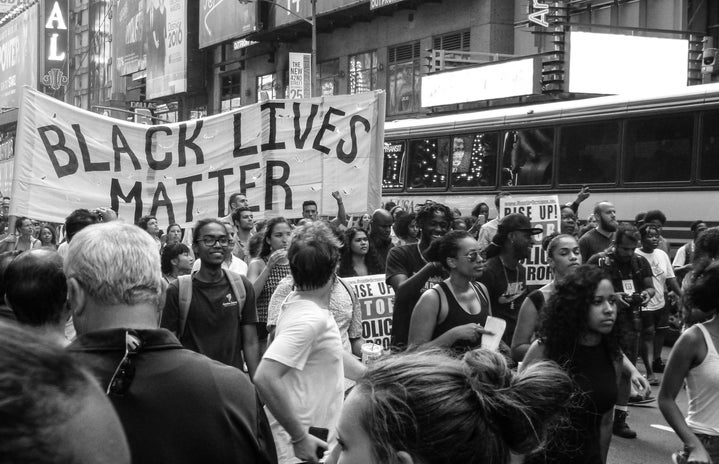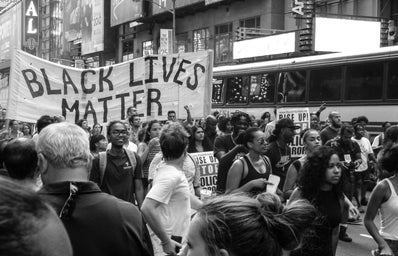In the wake of the racially charged murders of George Floyd, Breonna Taylor, Ahmaud Arbery, Tony McDade and countless others, people across the country are taking to the streets to protest against police brutality, racism and corrupt governments. Unfortunately, peaceful protesters are being punished for their involvement, and instigators–including some police–are starting riots to discredit the movement.
Her Campus supports Black Lives Matter, and everybody that is fighting to fix our broken system. We’ve put together this list of things to remember, to help keep everybody participating in demonstrations safe.

What to bring:
- A fanny pack or other small bag that you can secure close to yourself
- Hand sanitizer
- Two bandanas/face coverings (in case the first is contaminated)
- Cash (which can’t be tracked)
- Photo ID (don’t bring a fake!)
- First-aid supplies
- Snacks
- A camera, in lieu of your phone
- Non oil-based sunscreens
- A change of clothes
- Necessary/timely medications
What to leave behind
- Consider leaving your phone at home (you risk your movements being tracked by GPS, and they will confiscate it if you are arrested)
- Credit cards
- Your whole wallet
- Valuables
- Weapons
- Anything else you would not want the police to see
Wear a face mask
The Coronavirus remains a threat, even when fighting systemic injustice, and protests are going to be packed with people in close proximity, yelling, chanting, singing and more. This makes them viable hotspots for transmission, so don’t forget to wear your face mask, and encourage others attending to, as well. If you have the capacity to, bring extras along to pass out to those who don’t have one.
Wearing a larger mask or bandana over it can help to protect both your identity, should you be caught on camera (the last thing you want is to be doxxed–or having your private, personal information, like address, employer, etc.–blasted online by some anonymous asshole hiding behind his computer screen, or targeted by the police when you’re identified in a protest crowd photo), as well as provide a small protective barrier, should you find yourself in a cloud of pepper spray or tear gas (this won’t prevent the effects, but could lessen the impact if you have time to cover up and run). If your cover does become contaminated, make sure to remove it or throw it away quickly
Don’t wear contacts
If hit with pepper spray or tear gas, the irritants will more than likely become trapped beneath the lenses, causing increased irritation to your eyes. If you are hit while wearing contacts, remove and dispose of them immediately – they cannot be cleaned to a safe level to wear again.
If pepper sprayed, do not rinse your eyes with milk
Pepper sprays come in a variety of strengths and dispersal systems, from direct sprays to mists or fogs (which has the widest range). The type that police use are typically much stronger than what you’d be able to purchase for yourself online or at a sporting goods store.
According to How Stuff Works, Oleoresin capsicum (OC) is a natural oil found in hot peppers containing capsaicin, which can cause blisters on your skin in its purest form. For pepper spray, OC is mixed with an oil or water soluble solution and a propellant. The capsaicin reacts with your nerves, so when you’re sprayed in the face you can feel burning sensations in your eyes, nose, mouth and on your skin, and even in your throat. Depending on the strength and severity of the spray, your eyes may even swell shut.
If you’re hit with pepper spray (or tear gas), the best thing to do is to flush your eyes with water or saline. Many people suggest milk, which, according to Duke University Professor Sven Jordt, who’s studied the effects of tear gas for years, is thought to act as a buffer thanks to the fat and protein content. However, milk isn’t sterile, and you’re risking eye infections by flushing with it. Water won’t make the burning worse, despite popular misconceptions. It just doesn’t bond with the OC (taking it back to 3rd grade–oil and water won’t mix, or bond, due to their opposite polarities), so when you stop flushing, the burning returns, which may make it feel worse. Be careful of rinsing anything on your forehead into your eyes as well, and wash your face with a non-oil based soap or cleanser; oils (or greasy ointments, even if you think they’ll help with the burn) could trap the irritants between them and your skin.
If your clothes are contaminated as well, you should change as quickly as possible, and wash your body to avoid further burning for your own skin as well as transferring it to anyone you may touch.
Write your emergency contacts down on your arm
If you choose not to bring your phone, or if you’re arrested and they confiscate your phone, you’re going to want a few contacts handy, from your roommate (to come bail you out) to a lawyer or public defender’s office who have pledged to aid those arrested for protesting. Sharpie is probably best, so if you sweat a lot or have to wash yourself the numbers don’t easily rub off.
Alternatively, if you’re injured, you (or your EMTs and/or emergency nurses and doctors) will want to be able to contact someone who should know where you are and what’s happening.
Don’t wear jewelry, loose-fitting clothing, or your hair down
All of these are prime targets for grabby hands, and make it easier for somebody to pull you back or throw you to the ground, be it a cop, a counterprotestor, or someone else who’s just trying to run faster than you. Minimizing the things that others can grab gives you less of a chance of being pulled (but if your jewelry happens to be a medical alert bracelet, keep that on!).
Dress in layers
Don’t wear anything with identifying prints or logos. Solid-colored, layered clothing that is form fitting makes you harder to identify. Even if it’s warm out, long sleeves can help provide a protective layer between your body and any anti-riot chemicals, and will cover any tattoos that could identify you. With layers, you’ll be able to quickly shed your outer clothing if hit with tear gas or pepper spray, minimizing what touches your skin.
Know your rights
The ACLU has listed your rights as protestors in one convenient place. If you believe your rights are violated while protesting (such as police giving a dispersal order without proper time or paths to vacate the area, or detaining you for photographing or recording), take note of badge numbers, officer names, patrol car numbers, associated agencies, contact information for witnesses and photographs of injuries. This information can be used to file a complaint with the agency’s internal affairs or a civilian complaint board. This information will also be important if you end up needing a lawyer.


